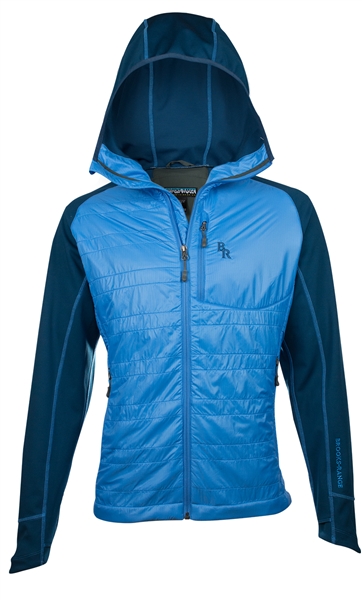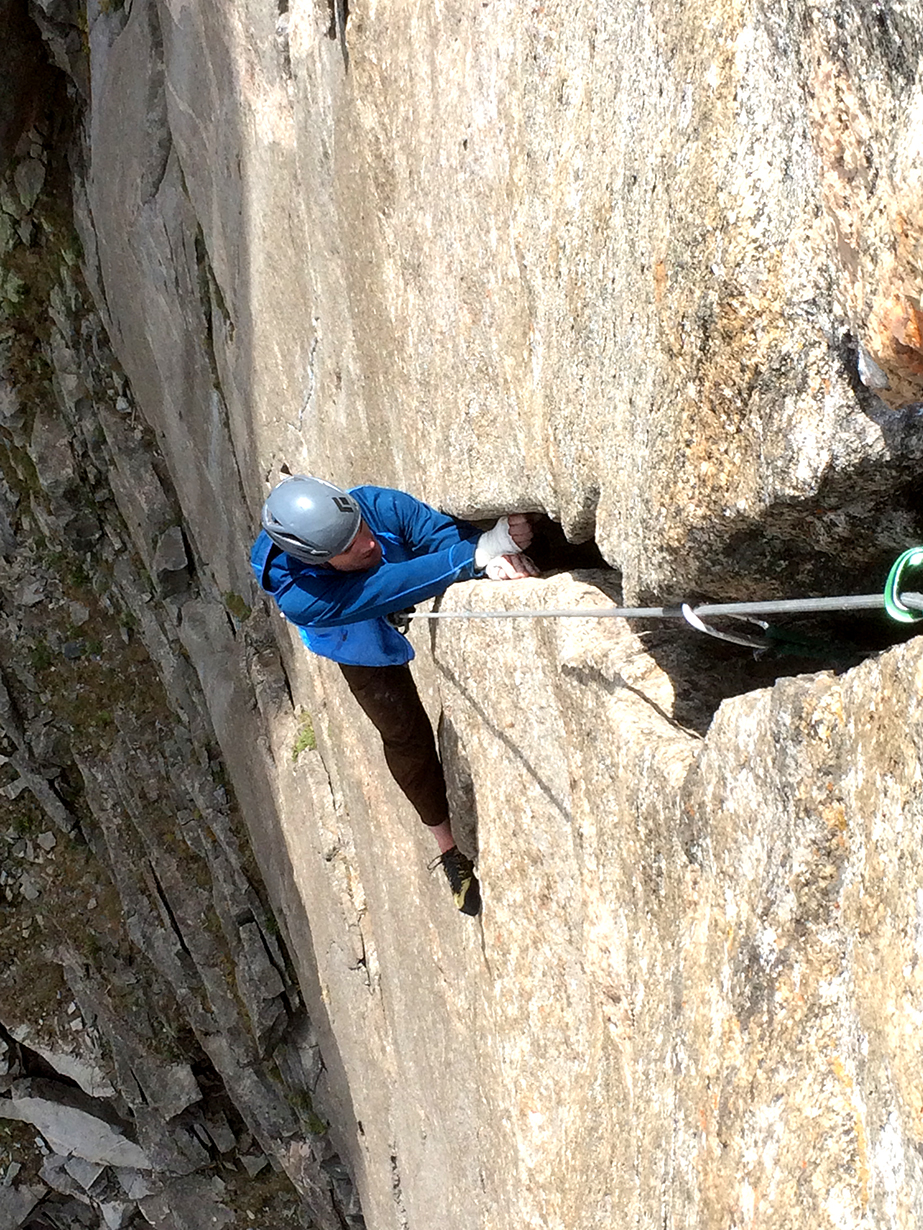
Brooks Range Mountaineering Alpha Softshell Jacket
Size Tested: Large
Blister’s Measured Weight: 546 g / 19.25 oz
Construction:
- Insulation: 60-g Polartec® Alpha®
- Fabric — Sleeves & Hood: Polartec® Power Shield
- Fabric — Body: 20D Nylon
Stated Features:
- Lightweight hood construction
- Chin guard
- Adjustable hem cord
- Thumb holes
- Asymmetrical cuffs
Pockets:
- Two zippered hand warmer pockets
- One zippered chest pocket
- Two drop-in interior pockets
MSRP: $259.95
Reviewer: 6’3”, 185 lbs
Days Tested: 14
Test Locations: Mt Evans, Rocky Mountain National Park, & South Platte, CO; Zion National Park, UT
Intro
Climbing presents a unique set of challenges when trying to find the right gear to bring, and this is particularly tricky with outerwear. Unpredictable weather and an inability to seek shelter while tethered to the wall goes against the goal of fast-and-light style. Furthermore, every item needs a place to live on the wall, and managing excess layers or gear becomes irritating at best, and a complete cluster at worst. In the end, packing for difficult climbs sometimes requires as much skill and experience as, well, the climb itself. The Brooks Range Mountaineering Alpha Softshell uses a unique combination of fabrics and insulation that aims to fulfill the many needs of a climbing layer: warm enough for chilly belays, durable enough to be worn on the pitch, and with a synthetic fill and shell fabric that covers you in light precipitation.
Construction
The Alpha Softshell combines lightweight fabrics and synthetic insulation around your core with a much more durable, tightly-woven fabric for the sleeves. This is similar in concept to the Marmot Alpha Pro Jacket, though there are some notable material and design differences separating these garments. I should note that these are both part of a wave a synthetic mid layers bearing confusingly similar names — this is due to the use of Polartec’s Alpha synthetic insulation.
If you’re unfamiliar with Polartec Alpha, it is a high-loft synthetic insulation that is knit together, rather than using discrete baffles, as is the case with down, or batted synthetic insulations like Primaloft. The main benefit here is that the knit helps immobilize the insulation, preventing it from migrating throughout the garment or through the face fabric itself (as down feathers tend to do). Since Alpha doesn’t require such tightly-woven face fabrics or baffles, designers can use looser, more breathable outer fabrics, a welcome improvement for active mid layers, especially for climbers. This results in a more breathable garment than traditional insulators, but with more weather resistance and durability than a fleece.
The front and back panels around the torso of the Alpha Softshell, which house the Polartec Alpha insulation, use a very lightweight 20-denier shell fabric. For reference, the Arc’teryx Atom SL (review coming soon) and many other lightweight mid layers use face fabrics with a similar yarn weight. The fabric is beefier than the ultralight fabrics found on the most minimal jackets, such as Patagonia’s Micropuff Hoody, but it’s still quite light. Personally, I think this is about as light as you can go with fabrics that are going to be used on the rock, or that will be tossed in a pack with your trad gear.
The Alpha Softshell’s sleeves are made from Polartec Power Shield, a tightly woven fleece-like material similar to the Polartec Power Dry Fleece used in the Marmot Alpha Pro. However, the Power Shield fabric on the Alpha Softshell features a slightly denser weave and includes a minimal air-permeable, water-resistant membrane that provides extra weather resistance. This jacket is certainly not waterproof, but it does buy you some time in a storm, and the insulated core does an admirable job of staying warm despite light precipitation.
Fit
The Alpha Softshell runs true to size, but fits looser than many other similar mid layers, such as the Arc’teryx Atom LT. The Large Alpha Softshell I wore has a 29” (~74 cm) front zipper, which sits at mid hip, but isn’t long enough to stay underneath my harness. Because the fit is loose enough, I found myself wearing the jacket on top of my harness rather than underneath. Though it isn’t necessarily ideal, this actually worked just fine (and is how you’re likely to be wearing it anyway, if you aren’t already wearing it once you don your harness). And I’m not sure there’s a better fix here — I wouldn’t want the jacket to be 6 inches longer just to stay under a hip belt, so I think making the jacket relaxed enough to sit over the harness is the best option.

The Alpha Softshell’s sleeves are plenty long for me, but the thumb loops at the end are a bit limiting — I can’t wear the jacket while using the thumb loops without limited range of motion, though I don’t typically climb with my thumbs in the loops anyway. The sleeves are lined with mesh, and the torso is lined with a thin, soft fabric that doesn’t feel clammy or stick to your skin.
Features
With the Alpha Softshell, Brooks Range carried over a feature I really liked from their Mojave Down Jacket — fleece-lined pockets. Often, front pockets are outside the insulation and unlined. With the Alpha Softshell, the pockets put your hands between the insulation and your body and have a comfy fleece lining — all the better for warming up quickly. The jacket also features a single chest pocket, a drawstring around the bottom that I never really use, and a stretchy hood that can be worn over a helmet. There are also two interior mesh drop-in pockets that don’t close, but are a good place to store gloves and the like.
Climbing Performance
I was most attracted to the Alpha Softshell because I wanted to find something that would work well while climbing in chilly conditions, even if I couldn’t take it off. Light mid layers, even synthetic ones, are great at delivering warmth and packability and are great at the belay, but I cringe at the thought of climbing abrasive pitches in them, fearful that the rock will destroy the fabric on the sleeves and shoulders. My usual approach is wearing the jacket at the belay, then either taking it off to climb or hiking up the sleeves and praying. So, I was eager to see if the Alpha Softshell could breathe well enough to be worn on the pitch but wouldn’t be torn to bits around the cuffs and arms.
What better way to test this out than a massive, sustained offwidth at 13,000 ft? Mt. Evans in Coloardo is home to Road Warrior, an alpine route featuring more than 200 ft of uninterrupted wide climbing with a brief pegmatite band offering the only respite from direct offwidthing. The crack is singular and beautiful, but also punishing and miserable; somehow alluring despite a clear threat to do irreparable damage to your arms, ankles, and dignity. My partner and I swung leads on Road Warrior, with him taking the first offwidth pitch and I the second, lending me the joy of climbing both pitches back-to-back. Here, the Alpha Softshell fared far better than I, surviving the experience with little to show for it.

Warmth and Breathability
The Alpha Softshell also breathes well, a quality it owes to the combination of the insulation and fabrics discussed earlier. This allows it to be worn as easily on the route as on the approach.
The Alpha Softshell is warmer and much more weather-resistant than the Patagonia R1, and is comparable in warmth and more durable than the Atom LT, but heavier and not as packable. In general, the Alpha Softshell is a shoulder-season jacket that can be worn either on cool-but-not-cold days, or on cold days when you’re on the move. Sitting sedentary in a shady belay on a cold November day will necessitate additional layers, but if you just want one layer to wear up a desert tower in the fall or bring on a longer day where you’ll be out after sunset, this is your jacket.

For these same reasons, the Alpha Softshell is a great big wall jacket — it’s durable enough to not get shredded by hooks, beaks, or the rest of the yardsale on your harness, and strikes the right balance of warmth and breathability to be worn while leading in aiders (a moderate activity — not as sedentary as belaying, not as demanding as hard free climbing).
Packability
This is the only aspect of the jacket that doesn’t get high honors. Mid layers like the Atom LT disappear into a pack easier and weigh less for only a modest hit to the level of warmth. The Power Shield material used for the Alpha Softshell’s sleeves breathes well while being able to resist light rain, but it’s not super packable. The Alpha Softshell, though, is really meant to be worn, rather than packed away. The jacket is at its best when you’re using it on the route, rather than breaking it out in short bursts just to stow it away again when you start moving.
Bottom Line
The Brooks Range Alpha Softshell is a mid layer that works especially well while climbing. The Power Shield fabric used in the sleeves and hood is a great choice for those locations on the jacket — a good compromise between insulation, light weather-resistance, and an ability to withstand the abrasive aspects of climbing. Meanwhile, the Polartec Alpha insulation in the torso provides enough warmth and breathability to be used during all phases of a long route. Especially for fall climbing, the Brooks Range Alpha Softshell is an extremely capable layer for use on the ground and on the rock.
